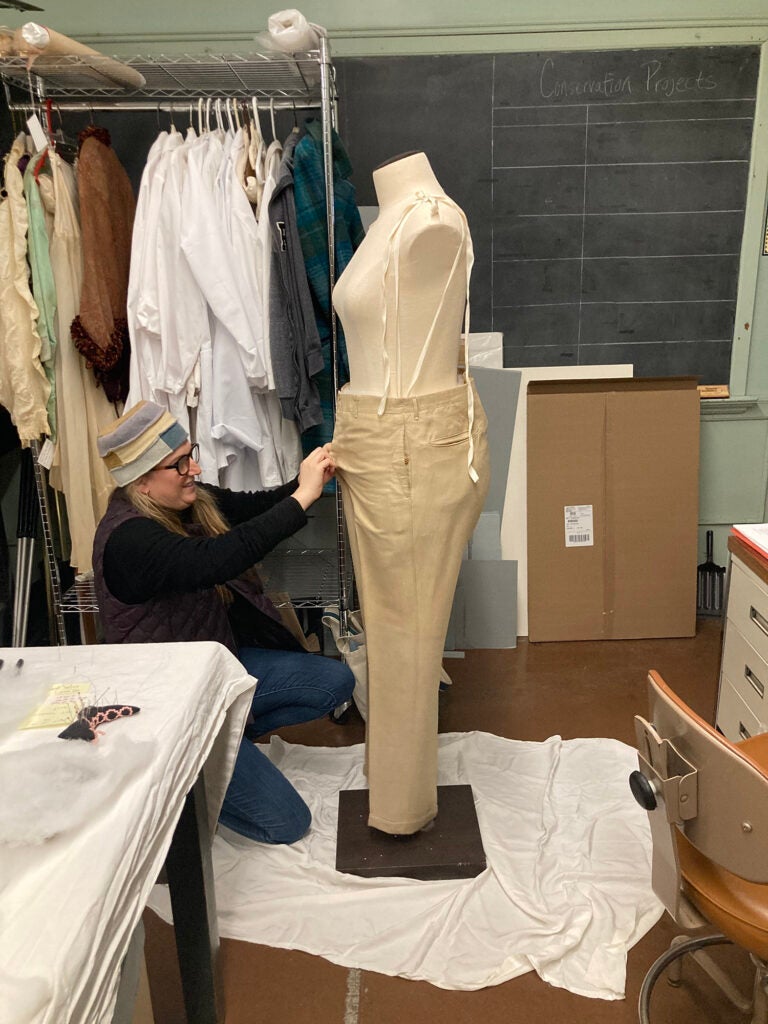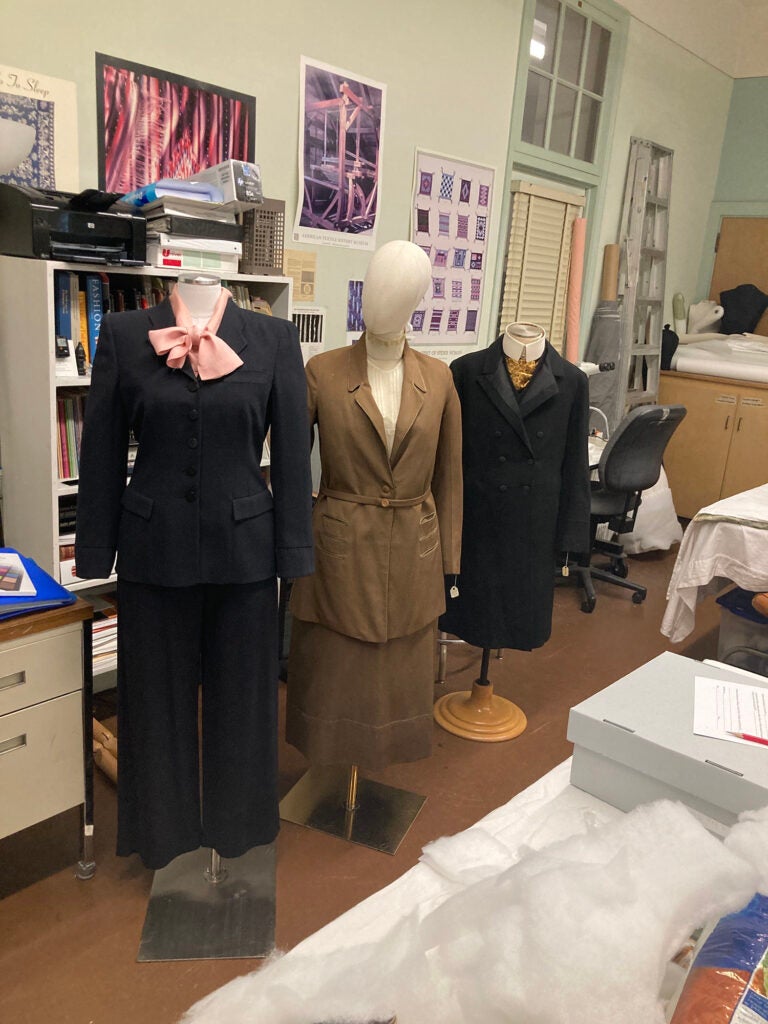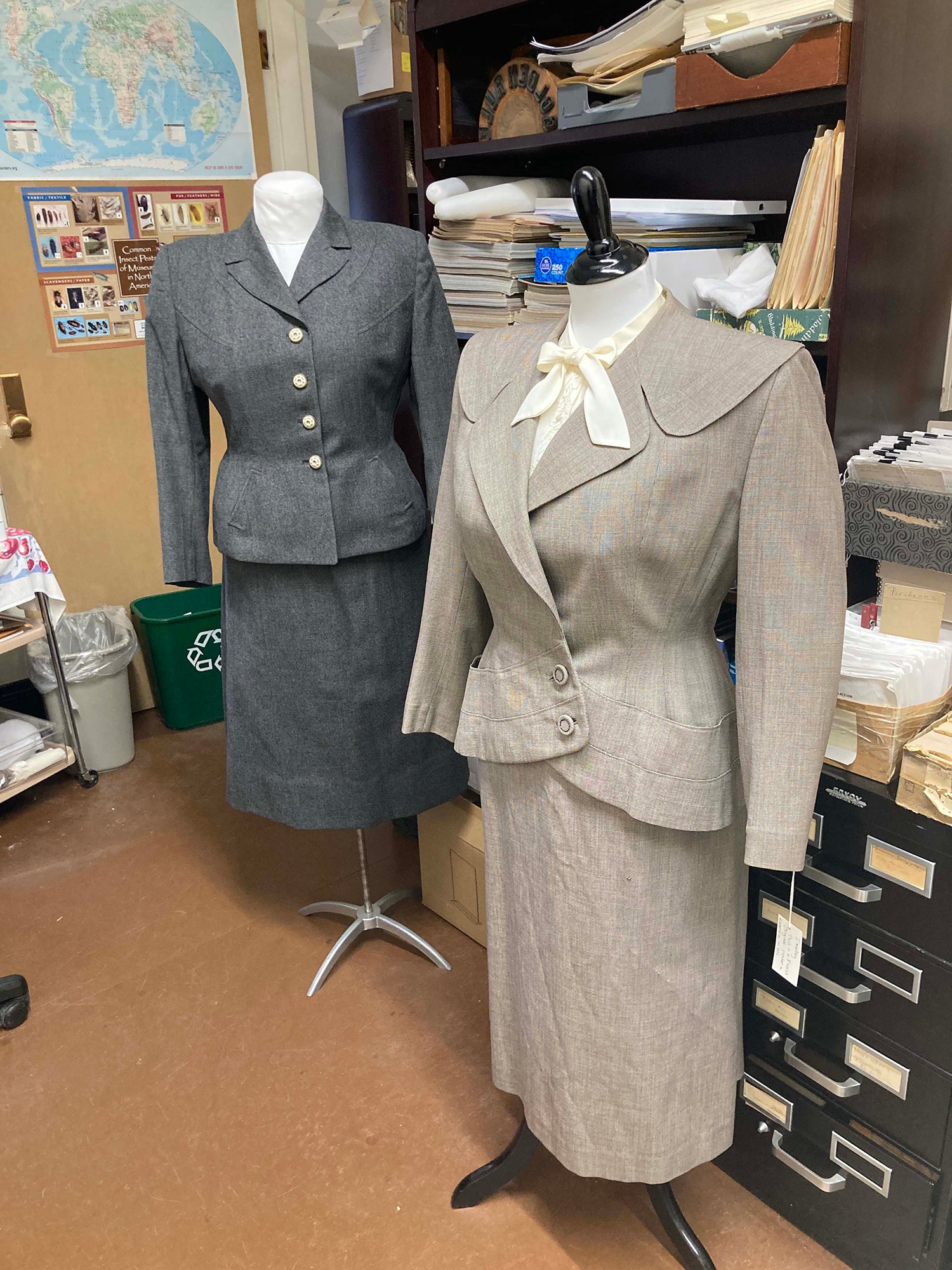KINGSTON, R.I. – March 17, 2023 – The power suit is far from dead. But in the last 100 years, it’s gone from the essential business wear for men and women to just one of the many choices available today for the high-powered executive or the nervous job seeker.
That is one of the storylines in a new exhibit, “Dressed for Business: A Retrospective Look at the Suit and Beyond (1923-2023),” that takes over the University of Rhode Island’s Textile Gallery in Quinn Hall starting Thursday, March 23. Presented by the Textiles, Fashion Merchandising and Design Department, the exhibit fits like a well-tailored suit with the College of Business’ 100th anniversary, providing a celebratory display of clothing from the University’s Historic Textiles and Costume Collection.
“The idea of dressing as a business person – typically a man – has evolved as society has changed,” says collections manager Susan Jerome, who curated the exhibit with adjunct professor Rebecca Kelly. “The sports coat with a tie replaced the uniform of the three-piece suit in the 1970s. Now in 2023, people remain a bit confused between casual and business and what is appropriate to wear in business settings. We live in a more casual world.”

The exhibit traces the trajectory of the business suit – from three-piece suits of the early 1900s that included vest, jacket and trousers, to a more modular look of sports coats and slacks that came into vogue in the 1970s, to the more casual, nearly-anything-goes dress of today.
The exhibit mixes a display of 13 women’s and men’s business suits and numerous accessories – ties, vests, shirts and shoes – to show the evolution of business dress. Adding to the story are numerous posters that combine URI yearbook photos across the decades along with fashion advertisements of the day.
“It’s been so much fun to go through the yearbooks,” says Jerome. “In 1920s, you have all these men sitting there in their dark suits and ties and then you start to see women infiltrating these groups. Then in the ’60s and ’70s, all hell is breaking loose and the concepts of dressing professionally are going down.”
“I think that has made it a challenge for young people trying to enter business and going to their first interview,” says Kelly. “There’s a lot of anxiety because the ‘Dress for Success’ manuals of the past now are not the hard and fast rules. I laugh at how much it’s changed in a very short time.”

For the exhibition, the story actually begins decades earlier – opening with a man’s cutaway tailcoat form the 1820s. The tailcoat – displayed with a cravat, the forerunner of the modern tie – “is probably the root of the modern suit,” says Kelly. “It came about in that time period when you start to see those three elements of a jacket, a vest and breaches in the 1820s. But then very quickly you start to have men wearing trousers for business more often.”
Through the suits on display, the norm goes progressively from formal to increasingly casual. As women enter the business world, their early business suits show elements of men’s attire. Men’s suit lapels grow (especially in the 1930s and ’40s) and then shrink. Fine fabrics, nice tailoring and beautiful details give way to synthetic fibers.
Like everything else, fashions are affected by times of political, economic and social changes of the day, says Jerome. And in the 1940s and ’50s, men’s and women’s suits show influences of the World War II era.
That is evident in a 1940s woman’s charcoal suit with a military cut, eased by elaborate buttons. The suit was one of two donated by a man whose aunt was a retail buyer at the old Gladding’s and Cherry & Webb department stores, Jerome says.
With the societal changes in the 1960s and ’70s, the URI yearbooks show an absence of the dress suit, which was a staple two decades before. “Nobody’s wearing a suit and there’s lots of facial hair,” says Jerome. “If you see a group of people and there’s one person in a suit, it’s the professor.”
“I do think formality lingers a bit with the women’s wear,” adds Kelly. “I think women who are high-powered in these business settings feel that the suit is part of their armor to enter this world.”
Today, “Dressed for Business” may mean different things to different professionals. The tech boom of the 1990s and 2000s – and the COVID-19 pandemic, which moved many workplaces online – have had their influence, Kelly says.
“If you think about somebody like Steve Jobs or Mark Zuckerberg, some of the most powerful people in the world go to work with a hooded sweatshirt or Patagonia vest and jeans and sneakers.” she says. “There is so much ambivalence toward this old idea of the power suit. Some people gravitate toward it and other people reject it.”
Jerome says one surprise as she and Kelly curated the exhibit is the URI collection’s absence of men’s clothing. “Women remain the clothing consumers and the collection is very heavy on women’s clothing,” she says. “We need to do more to collect men’s garments, accessories and especially shirts to be able to display a complete suit form various decades and centuries.”
An opening-night event will be held Thursday, March 23, at 6 p.m. Linda Welters, professor and director of the textiles and costume collection, will give a talk in the Quinn auditorium on “Dress for Success,” the 1970s movement that popularized the connection of clothing and a person’s success in business and personal life. There will also be tours of the exhibit and a chance to ask questions.
The exhibition will remain on display through December in the Textile Gallery on the first floor of Quinn Hall, 55 Lower College Road. The gallery is open Monday through Friday from 8 a.m. to 4 p.m. The exhibit is free and open to the public.
URI College of Business
The College of Business has been a leader in business education, research and outreach in Rhode Island since being established in 1923 by Howard Edwards, president of the then-Rhode Island State College. Accredited by the Association to Advance Collegiate Schools of Business, the College today has more than 2,300 undergraduate and about 350 graduate students across 10 undergraduate majors, nine graduate programs and three Ph.D. specializations.
As it turns 100, the College continues to innovate its offerings. New courses that focus on diversity, social entrepreneurship and innovation, and artificial intelligence have been added to the undergraduate curriculum. The College also launches new programs to keep with the times, including the Doctorate of Business Administration for working professionals, and FinTech, an undergraduate program in financial technologies.

